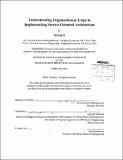Understanding organizational traps in implementing service-oriented architecture
Author(s)
Li, Xitong, Ph. D. Massachusetts Institute of Technology
DownloadFull printable version (2.339Mb)
Other Contributors
Sloan School of Management.
Advisor
Stuart E. Madnick.
Terms of use
Metadata
Show full item recordAbstract
One of the major objectives of implementing service-oriented architecture (SOA) is to enhance IS agility and improve IT-business alignment. However, the contradictory experiences about SOA implementation turn out to be a paradox: why many organizations failed to meet their expectations about SOA implementation efforts, while others succeeded? Contrast to prior research on SOA, this study adopts the process perspective and provides plausible theoretical explanations for the "SOA implementation paradox". The study uses multiple case studies and literature review to develop a system dynamics model which highlights the feedback loops and time delay during the SOA implementation process. The results reveal the dynamic characteristics of learning curve of SOA implementation and two organizational traps (technology learning trap and implementation effectiveness trap) associated with SOA implementation. The theory of the organizational traps can be generalized to a broad context of innovative IS implementation. Further, the theoretical causes of the traps are discussed.
Description
Thesis (S.M. in Management Research)--Massachusetts Institute of Technology, Sloan School of Management, 2013. Cataloged from PDF version of thesis. Includes bibliographical references (p. 57-63).
Date issued
2013Department
Sloan School of ManagementPublisher
Massachusetts Institute of Technology
Keywords
Sloan School of Management.